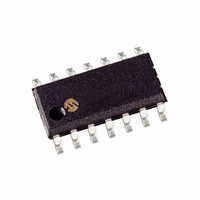HCS515/SL Microchip Technology, HCS515/SL Datasheet - Page 2

HCS515/SL
Manufacturer Part Number
HCS515/SL
Description
IC CODE HOPPING DECODER 14-SOIC
Manufacturer
Microchip Technology
Type
Code Hopping Decoderr
Specifications of HCS515/SL
Applications
Remote Secure Access, Keyless Entry
Mounting Type
Surface Mount
Package / Case
14-SOIC (3.9mm Width), 14-SOL
Ic Function
Code Hopping Decoder IC
Supply Voltage Range
4.5V To 5.5V
Operating Temperature Range
0°C To +70°C
Digital Ic Case Style
SOIC
No. Of Pins
14
Termination Type
SMD
Filter Terminals
SMD
Rohs Compliant
Yes
Lead Free Status / RoHS Status
Lead free / RoHS Compliant
Other names
HCS515/SLR
HCS515/SLR
HCS515/SLR
Available stocks
Company
Part Number
Manufacturer
Quantity
Price
Company:
Part Number:
HCS515/SL
Manufacturer:
MICROCHIP
Quantity:
12 000
HCS515
ations in transmitter data rate. The decoder contains
sophisticated error checking algorithms to ensure only
valid codes are accepted.
1.0
Key Terms
The following is a list of key terms used throughout this
data sheet. For additional information on K
Code Hopping, refer to Technical Brief 3 (TB003).
• RKE - Remote Keyless Entry
• Button Status - Indicates what button input(s)
• Code Hopping - A method by which a code,
• Code word - A block of data that is repeatedly
• Transmission - A data stream consisting of
• Crypt key - A unique and secret 64-bit number
• Encoder - A device that generates and encodes
• Encryption Algorithm - A recipe whereby data is
• Decoder - A device that decodes data received
• Decryption algorithm - A recipe whereby data
• Learn – Learning involves the receiver calculating
DS40183D-page 2
activated the transmission. Encompasses the 4
button status bits S3, S2, S1 and S0 (Figure 7-2).
viewed externally to the system, appears to
change unpredictably each time it is transmitted.
transmitted upon button activation (Figure 7-1).
repeating code words (Figure 7-1).
used to encrypt and decrypt data. In a symmetri-
cal block cipher such as the K
the encryption and decryption keys are equal and
will therefore be referred to generally as the crypt
key.
data.
scrambled using a crypt key. The data can only be
interpreted by the respective decryption algorithm
using the same crypt key.
from an encoder.
scrambled by an encryption algorithm can be
unscrambled using the same crypt key.
the transmitter’s appropriate crypt key, decrypting
the received hopping code and storing the serial
number, synchronization counter value and crypt
key in EEPROM. The K
itates several learning strategies to be imple-
mented on the decoder. The following are
examples of what can be done.
- Simple Learning
- Normal Learning
The receiver uses a fixed crypt key, common
to all components of all systems by the same
manufacturer, to decrypt the received code
word’s encrypted portion.
The receiver uses information transmitted
during normal operation to derive the crypt
key and decrypt the received code word’s
encrypted portion.
SYSTEM OVERVIEW
EE
L
OQ
EE
product family facil-
L
OQ
algorithm,
EE
L
OQ
and
• Manufacturer’s code – A unique and secret 64-
1.1
The HCS encoders have a small EEPROM array which
must be loaded with several parameters before use.
The most important of these values are:
• A crypt key that is generated at the time of pro-
• A 16-bit synchronization counter value
• A 28-bit serial number which is meant to be
The manufacturer programs the serial number for each
encoder at the time of production, while the ‘Key Gen-
eration Algorithm’ generates the crypt key (Figure 1-1).
Inputs to the key generation algorithm typically consist
of the encoder’s serial number and a 64-bit manufac-
turer’s code, which the manufacturer creates.
- Secure Learn
bit number used to generate unique encoder crypt
keys. Each encoder is programmed with a crypt
key that is a function of the manufacturer’s code.
Each decoder is programmed with the manufac-
turer code itself.
duction
unique for every encoder
Note:
The transmitter is activated through a special
button combination to transmit a stored 60-bit
seed value used to generate the transmitter’s
crypt key. The receiver uses this seed value
to derive the same crypt key and decrypt the
received code word’s encrypted portion.
HCS Encoder Overview
The manufacturer code is a pivotal part of
the system’s overall security. Conse-
quently, all possible precautions must be
taken and maintained for this code.
2002 Microchip Technology Inc.















